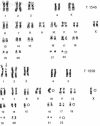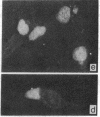Abstract
Two out of seven meningiomas tested in early cell cultures by indirect immunofluorescence staining showed simian virus 40 (SV40)-related tumor (T) antigen. In one tumor 90% of the cells were positive. An additional SV40-related antigen (U) was found in 10% of cells of a third tumor. These findings indicate that the meningioma cells showing a positive reaction are transformed by a papova virus that has at least partly the same antigenic properties as SV40 virus. SV40-related viral capsid (V) antigen was absent in all the meningiomas tested. No virus infectious for African green monkey kidney (AGMK) cells could be isolated. The tumors positive for T and U antigens showed the chromosome aberration typical for human meningiomas, i.e., the loss of one chromosome, G-22. The T-antigen-positive tumors showed further hypodiploidization. Experiments to rescue virus from the T-antigen-positive tumors showed further hypodiploidization. Experiments to rescue virus from the T-antigen-positive meningioma cells were performed: fusion of cells pretreated with 8-azaguanine with cells premissive for SV40 led to a low percentage (0.01-0.05%) of V-antigen-positive nuclei in heterokaryon cultures. On the basis of these results, the possibility of a correlation between the meningioma, a relatively common intracranial tumor in man, and an SV40-related papova virus must be considered. It remains to be shown whether this virus is a causative agent for human meningiomas.
Full text
PDF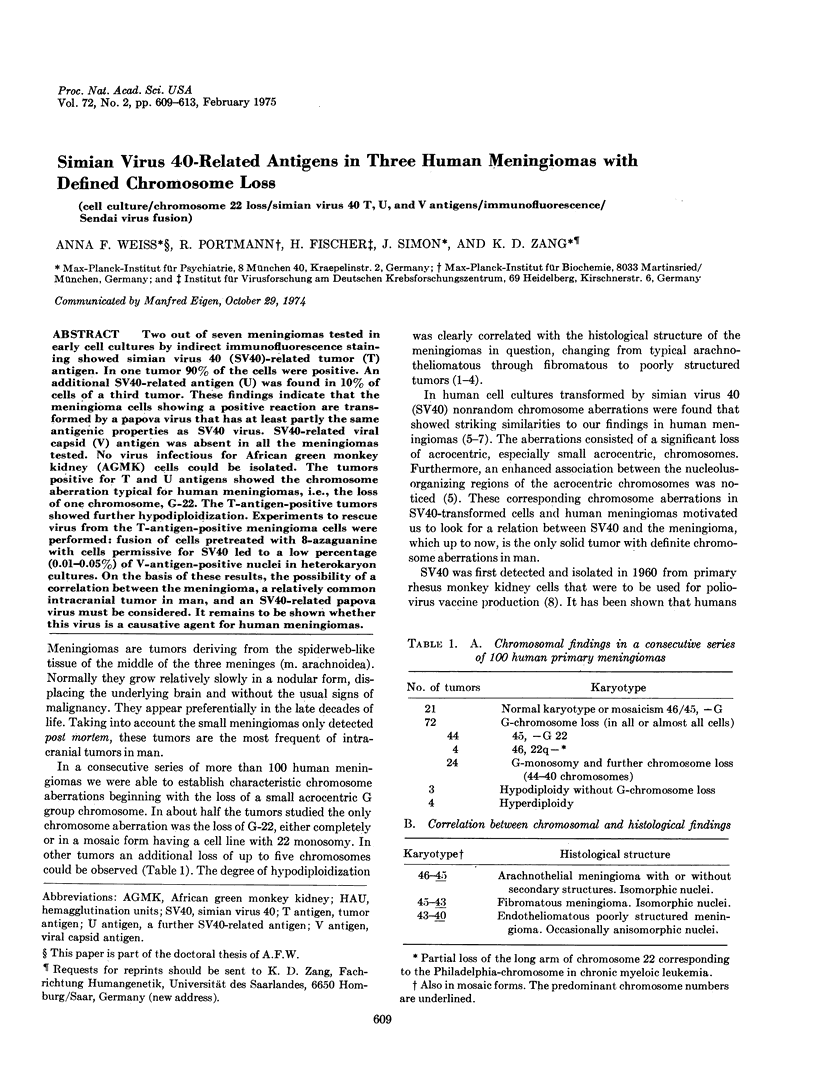
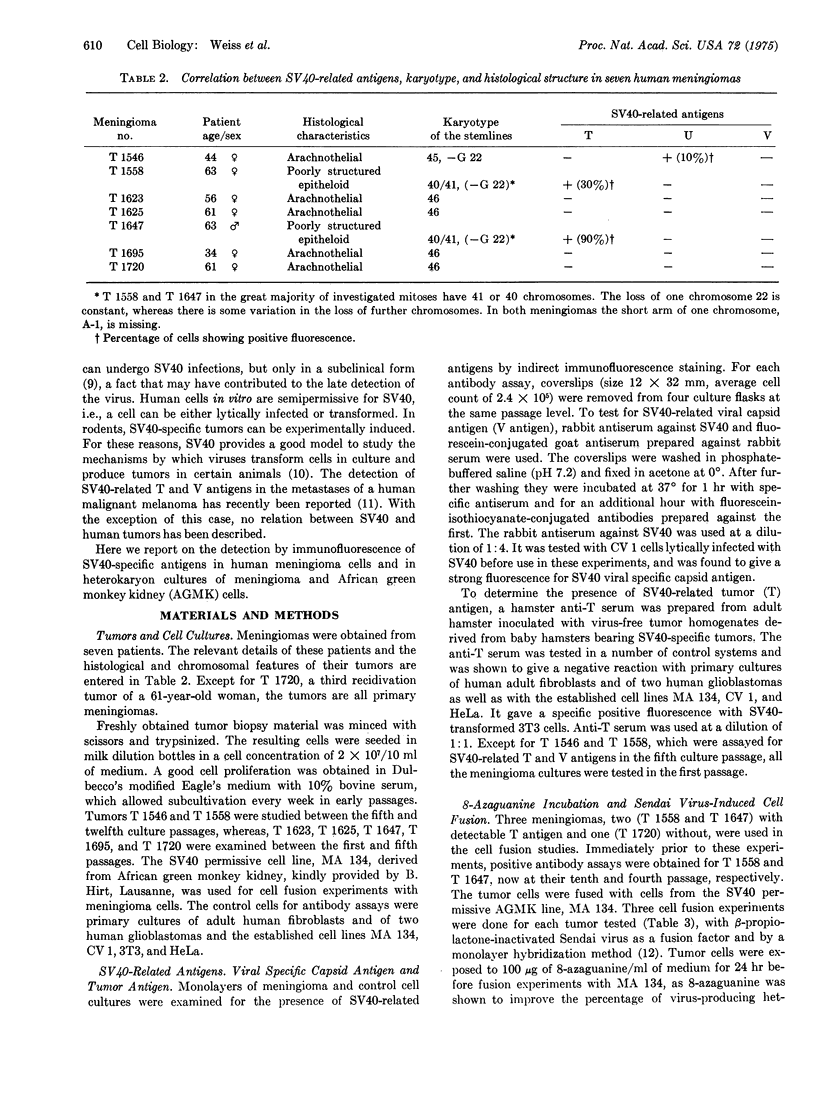
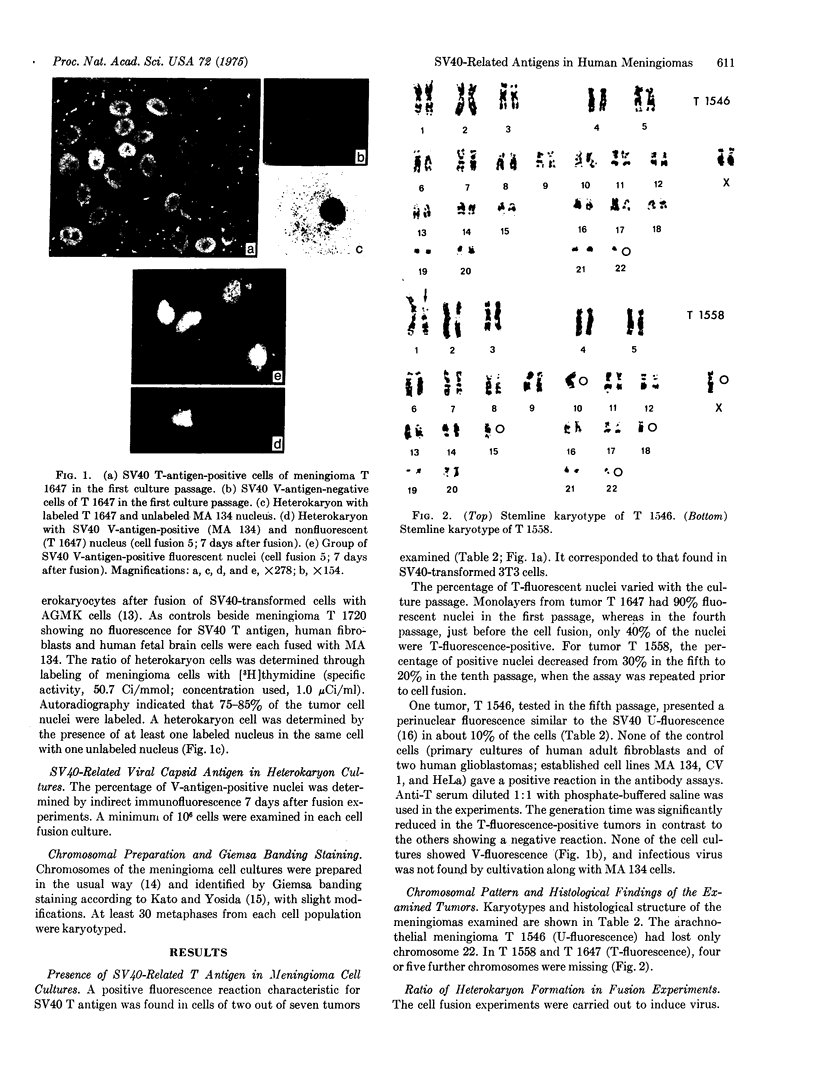
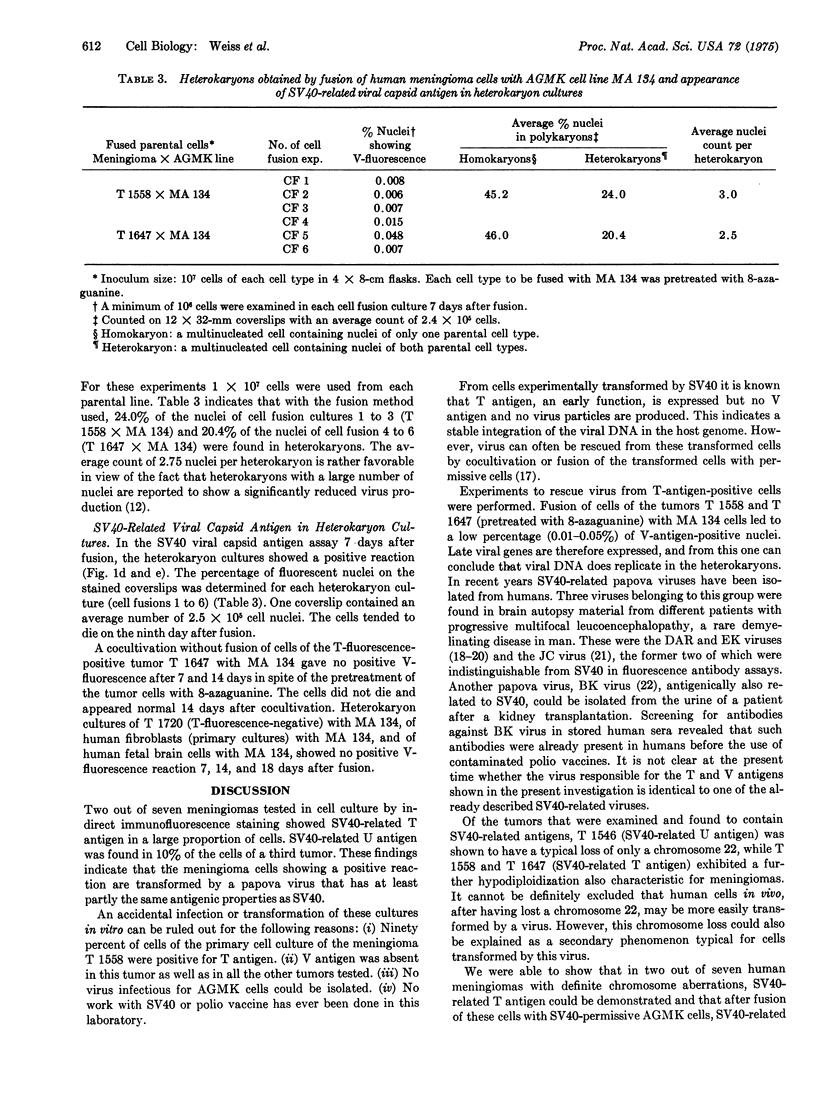
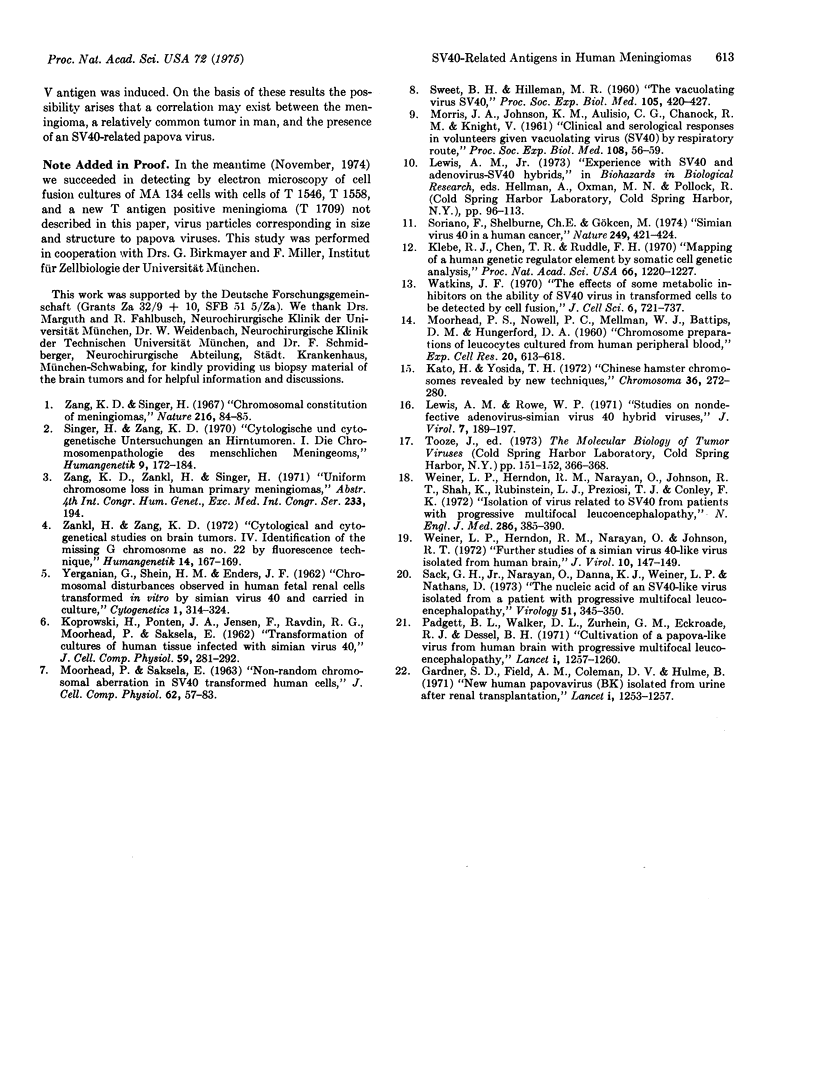
Images in this article
Selected References
These references are in PubMed. This may not be the complete list of references from this article.
- Gardner S. D., Field A. M., Coleman D. V., Hulme B. New human papovavirus (B.K.) isolated from urine after renal transplantation. Lancet. 1971 Jun 19;1(7712):1253–1257. doi: 10.1016/s0140-6736(71)91776-4. [DOI] [PubMed] [Google Scholar]
- Kato H., Yosida T. H. Banding patterns of Chinese hamster chromosomes revealed by new techniques. Chromosoma. 1972;36(3):272–280. doi: 10.1007/BF00283246. [DOI] [PubMed] [Google Scholar]
- Klebe R. J., Chen T., Ruddle R. H. Mapping of a human genetic regulator element by somatic cell genetic analysis. Proc Natl Acad Sci U S A. 1970 Aug;66(4):1220–1227. doi: 10.1073/pnas.66.4.1220. [DOI] [PMC free article] [PubMed] [Google Scholar]
- Lewis A. M., Jr, Rowe W. P. Studies on nondefective adenovirus-simian virus 40 hybrid viruses. I. A newly characterized simian virus 40 antigen induced by the Ad2+ND 1 virus. J Virol. 1971 Feb;7(2):189–197. doi: 10.1128/jvi.7.2.189-197.1971. [DOI] [PMC free article] [PubMed] [Google Scholar]
- MOORHEAD P. S., NOWELL P. C., MELLMAN W. J., BATTIPS D. M., HUNGERFORD D. A. Chromosome preparations of leukocytes cultured from human peripheral blood. Exp Cell Res. 1960 Sep;20:613–616. doi: 10.1016/0014-4827(60)90138-5. [DOI] [PubMed] [Google Scholar]
- MOORHEAD P. S., SAKSELA E. NON-RANDOM CHROMOSOMAL ABERRATIONS IN SV 40-TRANSFORMED HUMAN CELLS. J Cell Physiol. 1963 Aug;62:57–83. doi: 10.1002/jcp.1030620109. [DOI] [PubMed] [Google Scholar]
- MORRIS J. A., JOHNSON K. M., AULISIO C. G., CHANOCK R. M., KNIGHT V. Clinical and serologic responses in volunteers given vacuolating virus (SV-40) by respiratory route. Proc Soc Exp Biol Med. 1961 Oct;108:56–59. doi: 10.3181/00379727-108-26843. [DOI] [PubMed] [Google Scholar]
- Padgett B. L., Walker D. L., ZuRhein G. M., Eckroade R. J., Dessel B. H. Cultivation of papova-like virus from human brain with progressive multifocal leucoencephalopathy. Lancet. 1971 Jun 19;1(7712):1257–1260. doi: 10.1016/s0140-6736(71)91777-6. [DOI] [PubMed] [Google Scholar]
- SWEET B. H., HILLEMAN M. R. The vacuolating virus, S.V. 40. Proc Soc Exp Biol Med. 1960 Nov;105:420–427. doi: 10.3181/00379727-105-26128. [DOI] [PubMed] [Google Scholar]
- Sack G. H., Jr, Narayan O., Danna K. J., Weiner L. P., Nathans D. The nucleic acid of an SV40-like virus isolated from a patient with progressive multifocal leukoencephalopathy. Virology. 1973 Feb;51(2):345–350. doi: 10.1016/0042-6822(73)90433-9. [DOI] [PubMed] [Google Scholar]
- Singer H., Zang K. D. Cytologische und cytogenetische Untersuchungen an Hirntumoren. I. Die Chromosomenpathologie des menschlichen Meningeoms. Humangenetik. 1970;9(2):172–184. doi: 10.1007/BF00278933. [DOI] [PubMed] [Google Scholar]
- Soriano F., Shelburne C. E., Gökcen M. Simian virus 40 in a human cancer. Nature. 1974 May 31;249(456):421–424. doi: 10.1038/249421a0. [DOI] [PubMed] [Google Scholar]
- Watkins J. F. The effects of some metabolic inhibitors on the ability of SV40 virus in transformed cells to be detected by cell fusion. J Cell Sci. 1970 May;6(3):721–737. doi: 10.1242/jcs.6.3.721. [DOI] [PubMed] [Google Scholar]
- Weiner L. P., Herndon R. M., Narayan O., Johnson R. T. Further studies of a simian virus 40-like virus isolated from human brain. J Virol. 1972 Jul;10(1):147–149. doi: 10.1128/jvi.10.1.147-149.1972. [DOI] [PMC free article] [PubMed] [Google Scholar]
- Weiner L. P., Herndon R. M., Narayan O., Johnson R. T., Shah K., Rubinstein L. J., Preziosi T. J., Conley F. K. Isolation of virus related to SV40 from patients with progressive multifocal leukoencephalopathy. N Engl J Med. 1972 Feb 24;286(8):385–390. doi: 10.1056/NEJM197202242860801. [DOI] [PubMed] [Google Scholar]
- YERGANIAN G., SHEIN H. M., ENDERS J. F. Chromosomal disturbances observed in human fetal renal cells transformed in vitro by simian virus 40 and carried in culture. Cytogenetics. 1962;1:314–324. doi: 10.1159/000129742. [DOI] [PubMed] [Google Scholar]
- Zang K. D., Singer H. Chromosomal consitution of meningiomas. Nature. 1967 Oct 7;216(5110):84–85. doi: 10.1038/216084a0. [DOI] [PubMed] [Google Scholar]
- Zankl H., Zang K. D. Cytological and cytogenetical studies on brain tumors. 4. Identification of the missing G chromosome in human meningiomas as no. 22 by fluorescence technique. Humangenetik. 1972;14(2):167–169. doi: 10.1007/BF00273305. [DOI] [PubMed] [Google Scholar]



